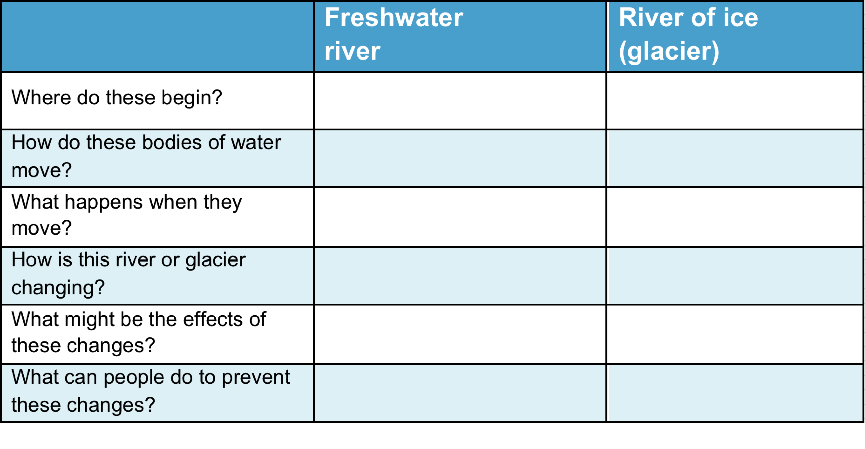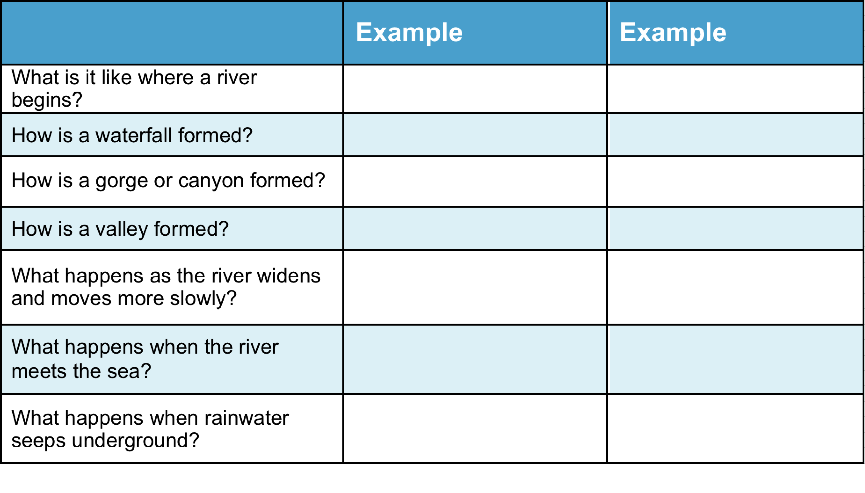Information for Teachers
Curriculum links
Australian Science Standards
CS (ACSSU077) Different observable properties and behaviours of solids, liquids and gases
UIS (ACSHE083) Scientific knowledge is used to solve problems and inform personal and community decisions
New Zealand Science Achievement Objectives
PEB: The external and internal processes that shape and change the surface features of the land
LW: The importance of variation within a changing environment
Helpful websites
You may want to direct your students to websites to help with their investigations.
Students may want to learn more about one landform that is shaped by moving water. They can do a search for the name of the landform (e.g. canyon)+moving water or how a river forms a canyon by searching river+canyon+formation
Search for glaciers in the same way: glacier+new landforms
How to search the internet
1 Keep your request short
Fewer words will give a more accurate search.
2 Choose exactly what you want
For example: Arctic Circle Climate
3 Use quotes
Double quotes around a set of words tell the search engine to consider those exact words in that exact order without any change. For example: “Arctic Circle Climate”
4 Use the plus sign (+)
If you add a plus sign (+) between words, the internet will search for all the words. For example: migrate+birds+whales+mammal
5 Use the minus sign (–) to say what you don’t want
Use a minus sign (–) to show words you do not want to appear in your results. For example: if you search for burrowing animals and do not want mammals in your search, –mammals will exclude mammals. Note that you need to put a space before the minus sign for the word to be excluded.
6 Be very clear about what you don’t want
Part 1
Ask questions and make predictions
After reading How Water Shapes the Land, you may have many questions about where freshwater comes from, how it travels across the land, and changes the shape of the land.
List your questions
- Compare your list with questions that others have.
- Choose a question you would like to investigate.
- You can work alone, with a partner, or in a small group.
You may want to choose one or more of these questions to investigate
Q1. What are the forms of freshwater?
Q2. Where does the water that flows over the land go?
Q3. How are landforms changed by moving water?
Q4. Why is freshwater precious and how are people trying to conserve it?
Go to Part 2 Plan and investigate →Part 2
Plan and investigate
Once you have decided on your question, try searches in the internet or in books or talk to people who can help to find the information you are looking for.
Your teacher may suggest suitable websites for further information.
Go to Part 3 Record and analyse data →Part 3
Record and analyse data
Find a way of recording your information that will allow you to see any patterns in the data.
Data Chart for How Water Shapes The Land
[Download and change to suit your information]
 Download Chart
Download Chart
Go to Part 4 Evaluate the information →
Part 4
Evaluate the information
1. Look over the information you have gathered and the patterns you have found.
What happens when large amounts of rain or snow fall?
How do these rivers and glaciers change the shape of the land?
2. Search for other patterns.
What have people done to change this river or glacier?
What might happen if these changes continue?
What are people doing to conserve freshwater?
3. Make notes about what you find.
Go to Part 5 Communicate and share ideas →Part 5
Communicate and share ideas
Look over all of the information that you have gathered in your investigation.
What are the most important ideas about how freshwater shapes the land?
Make a chart showing the most important ideas.
 Download Chart
Download Chart
← Return to menu
